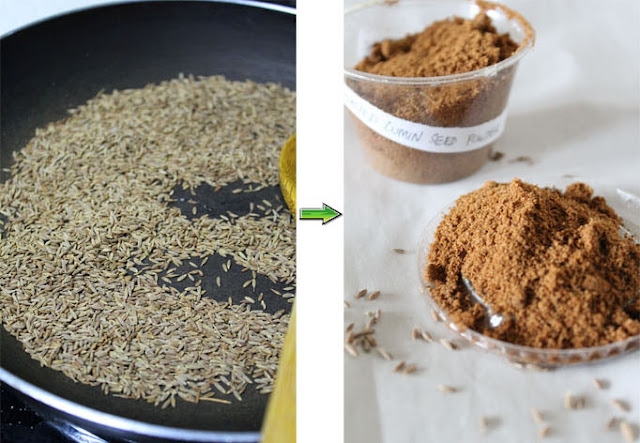After I came to US, I thought some items in the grocery stores here were incomprehensible, such as some powdered spices, pastes, chopped vegetables, or say, peeled garlic. I wondered why people bought them? Then I guessed it was probably because the fast-paced life, working couples, and independent families do not have time for menial jobs.
I understand that for busy people making ginger, garlic, and green chili pastes or clarified butter (ghee) at home may be time-consuming, but then, it is a one-time effort and the pastes or ghee last well for months.
In addition to that, certain basic masalas and powders that take lesser time to prepare and store well are a pretty good idea to make at home too. Especially those that are frequently needed in cooking Indian food and are simple enough to make. I personally think buying them from stores is unnecessary.
 |
| making basic powders for Indian cuisine at home instead of purchasing from the store |
In addition to that, certain basic masalas and powders that take lesser time to prepare and store well are a pretty good idea to make at home too. Especially those that are frequently needed in cooking Indian food and are simple enough to make. I personally think buying them from stores is unnecessary.
Sesame Seeds – How to Make Roasted Sesame Powder at Home
Whether you add sesame seeds to a stir-fry or roasted sesame powder to a baingan sabji, they add a very unique taste. Toast sesame seeds evenly in a pan until light brown on medium heat, let cool, grind, store in air tight container in pantry, and use it for months. That's it. It is THIS simple to make sesame seed powder at home.
 |
| making sesame seed powder at home |
Raw Peanuts – How to Make Roasted Peanut Powder at Home
Add peanuts in a poha for breakfast or ground peanuts in an okra sabji, the nutty flavor adds a punch in any dish. Dry roast peanuts (without any oil) on medium heat in a pan, let cool, rub altogether to remove skin or leave as is and grind, store in an airtight container at room temperature in your pantry, and use it for months.
 |
| making roasted peanut powder at home |
Cumin Seeds – How to Make Roasted Cumin Powder at Home
 |
| making roasted cumin powder at home |
Fresh Bread – How to Make Breadcrumbs at Home
Whether for using bread to make Double ka Meetha or rolling patties in breadcrumbs before frying, if you cannot use up remaining bread within its expiration date and do not want to waste the slices - make breadcrumbs. Whether you use store-bought white bread or choose to bake your own white bread at home: toast the slices on both sides in a toaster oven for 3-5 minutes, depending on heat intensity, let cool, grind, store in airtight container in your refrigerator, and use it for weeks. That's it. It is THIS simple to make breadcrumbs at home.
 |
| making breadcrumbs at home |
Sambar Powder
Sambar, the celebrated stew from South Indian cuisine that is amazingly flavorful and contains plenty vegetables, has the secret ingredient Sambar Powder. Everyone has their unique recipe of making this powder. Although making this at home is fairy easy, it is preferable to buy the powder from a good brand.
 |
| making sambar powder at home |
These and other common powders (such as chaat masala and garam masala) are very basic things that can easily be ground at home and are good to have handy; in fact a lot of Indian kitchens already do. Here are few more: Vimitha's Curry Leaves Powder, Namitha's Coriander Powder, Fathima's Pepper-Cumin Powder, Rasya's Curry Powder.
In addition to the masalas, I also remember from my childhood how my granny (naniji) and her daughter-in-laws (my mamijis) made all sorts of pickles [raw mango, lime, etc], rolled out papads and piped out mangodis on the terrace in summers and left them to dry under the sun. All stored and stocked up well to last a whole year.
What other homemade powders, pastes, etc do you make and keep?
Connect with Spusht : Facebook | Email | RSS | Twitter
